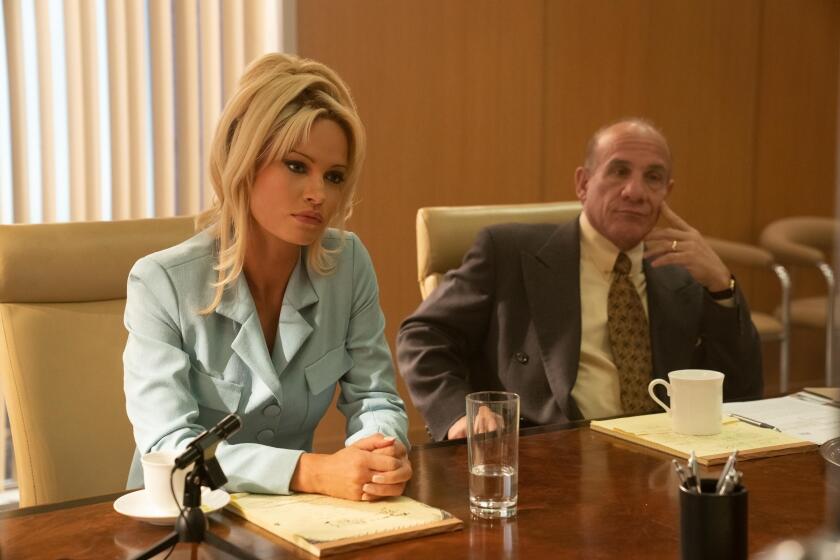“Pam & Tommy” normally takes a rollicking look back again at one of the most salacious tales of the 1990s — the personal property film created by Mötley Crüe drummer Tommy Lee and “Baywatch” star Pamela Anderson through the early days of their unstable relationship, subsequently stolen from their household by a disgruntled electrician, then offered with no their consent on the web.
Made by Robert Siegel, the collection presents a sprawling, diffuse search at the tradition of the mid-1990s, touching on every thing from the misogyny of late-night time Television set and transforming style in well-known songs to the mechanics of the early net and the role of the VCR in the pre-world wide web porn marketplace.
It has specified viewers a great deal to ponder, together with a talking penis.
But until finally Wednesday, it experienced largely left Anderson’s backstory unexplored. Now, with “Pamela in Wonderland,” “Pam & Tommy” delivers a potent episode that puts her viewpoint front and middle.
Written by Sarah Gubbins (a playwright and screenwriter whose credits contain “Better Things” and “Shirley”) and directed by Hannah Fidell (“The Act,” “A Teacher”), the episode opens as Anderson (Lily James) prepares to be deposed as element of a lawsuit she and Lee (Sebastian Stan) have filed against Penthouse magazine for publishing stills from the movie.
As Anderson is grilled with degrading questions like “Do you remember how outdated you have been the very first time you publicly exposed your genitals?” and pressured to discover herself in the stolen intercourse tape as it’s performed for a room entire of strangers, the episode flashes back to trace her journey from Ladysmith, Canada, to the Playboy Mansion and over and above.
It all starts in August 1989, when a young Anderson is discovered in the crowd at a football activity, foremost to a stint as a beer spokesmodel and, finally, a get in touch with from Playboy. Soon after ditching her violent and controlling boyfriend, she travels to Los Angeles for her first pictorial. Originally nervous, she promptly will come to lifetime in entrance of the digital camera. A star is born.
Both equally Gubbins and Fidell say they ended up keen to work on this episode simply because of its concentration on Anderson.
“There’s so considerably depth, and it is so layered, and I’m individually just drawn to stories of gals in disaster,” Fidell reported. “It just seemed like, actually, the standout episode.”
Here’s a glimpse at how they introduced her facet of the tale to lifetime.

Lily James and Brent Antonello in “Pam & Tommy.”
(Erin Simkin/Hulu)
I am fascinated in the research you did for this episode and how deep down the rabbit hole you went, setting up with the deposition. Did you dig up the actual transcripts?
Gubbins: I went quite deep. I arrive from a spouse and children of legal professionals. The regulation is a thing that I’m fascinated by, and I enjoy examining depositions. This is anything I definitely hope you really don’t print, since I’ll by no means get invited to any amazing situations at any time yet again. [Laughs] We petitioned aggressively to get as lots of of the legal documents as were being obtainable. I did a good deal of Lexis Nexis searches and got descriptions of several features of what happened in the court docket. But finally the deposition itself is a reconstruction for television of what could have been prompts in that deposition, constructing back from the consequence of the scenario.
So you imagined what the dialogue may have been like, provided the standard discourse all around the situation and the final result of the lawsuit?
Gubbins: Yes, and I was equipped to nail down such issues as traces of questioning with no being presented immediate inquiries, if that can make perception. I was in a position to get a feeling of the tenor of the deposition and the remedy of her. Depositions are not meant to be quick factors no matter of what you’re getting deposed for, but this seemed to be an an excessively egregious cure of Pamela, individual from Tommy. And which is all based in what we were ready to get in the legal investigate.
Was she created to observe the tape with other persons, as we see in the episode?
Gubbins: I really don’t know if which is a true detail, but I do know that it is a typical deponent apply to have to determine oneself in proof they would be offered with. It is pretty much like common exercise.
Fidell: I also appear from a family members of lawyers. And I ran this by them to make confident it kind of stood up to their scrutiny and it handed muster.
One thing else that stood out to me is the sequence at the Playboy Mansion where by she poses nude for the initial time. She is uncertain at initial but seriously will come alive and would seem happy by the conclude of the shoot. It doesn’t truly feel exploitative. What had been you making an attempt to convey in that scene?
Fidell: I believe we used the most time speaking about that sequence. Pam cherished posing for Playboy she was superior at it, it was empowering for her, she took possession above it and ownership over her physique. And getting that as an psychological journey more than the system of all those couple of minutes was quite essential to the arc of the episode. We designed confident that she started off out anxious and then obtained self esteem by the close of it — really owned the place — and became the Pam that absolutely everyone understands now.

Lily James as Pamela Anderson and Sebastian Stan as Tommy Lee in “Pam & Tommy.”
(Erin Simkin / Hulu)
When you were exploring the coverage of the lawsuit at the time, what struck you about it?
Gubbins: We read through a bunch of news coverage from when the tape arrived out, and I was genuinely struck by how, across the board, it was taken care of with this sort of misogyny. I do not keep in mind when the term “slut-shaming” arrived into the well known parlance, I don’t imagine that was something that was dripping off of people’s tongues [in the ‘90s], but from the lens of our existing day, it was jaw-dropping to me how overt the misogyny was, and the way in which Pam compared to Tommy were dealt with in the coverage.
We have seen a variety of initiatives reconsidering females from this period: Britney Spears, Monica Lewinsky, Marcia Clark and now Pamela Anderson. The society really looks to be reckoning with the sexism of the ‘90s. I wonder if you have ideas about why now and what has shifted in the lifestyle that tends to make us additional conscious of the way we taken care of these women at the time?
Gubbins: I do not feel that it is coincidental. I believe it’s quite important to go again to the ‘90s. For the reason that this is a instant, politically talking, wherever females have attempted to occur into different positions of energy and agency in lots of arenas. And the wrestle to define what are inherent biases about girls in power and exactly where they stem from is generational. We are going back again to the ‘90s and declaring, “Where did this get started for us?” We’re reexamining anything that we did not even understand we had been expanding up with. And I’m saying that as any person who’s in my mid-40s.
We’re seeking to grapple with what is effervescent up, this persistent misogyny. Why are we so not comfortable giving women a voice? Why are we so awkward providing women a seat at the desk? Where by did that arrive from for us? And heading back to these situations of the ‘90s is going to enable us reply individuals issues.
When it came to filming this episode, were being you mindful of framing Pamela in approaches that ended up different from how she was typically portrayed — avoiding the male gaze and ogling her system by means of the digicam?
Fidell: Of course, extremely considerably — speaking of internalized misogyny. Paula [Huidobro], the director of images, is a female. And both equally of us arrived to this episode from a position of truly seeking the viewers to empathize with Pam. And the way to do that, just from a technological standpoint, is to not have a conventional male gaze. Since then the female matter turns into objectified. So it’s producing positive that the digicam is shut when we want her to really feel claustrophobic. The Playboy Mansion feels exciting, so we shoot it with a vast lens. It really desires to mirror every little thing that she is emotion in the minute. So we produced absolutely sure that that was our mantra transferring forward.
From the begin I thought this episode ought to seem various than the preceding kinds, since we’re truly paying the entirety of the episode in her perspective. It should not seem like how Rand or Tommy’s scenes would seem and sense, in particular for those people Playboy [scenes]. We utilized the precise initial Playboy shots that she took and attempted to mimic them as ideal we could. There’s a large amount of reference content to pull from, which was excellent for all of the heads of departments, but specifically for Lily.
You convey to her story quite economically, in just in excess of 30 minutes of display time. How did you choose which times from her lifetime to involve in this episode?
Gubbins: I felt it was definitely important to discover moments of company, exactly where she was becoming specified a selection. That stands in stark contrast to acquiring some own assets burglarized and then blasted across the web. Dramaturgically that is what’s driving all those flashbacks. Emotionally she’s recounting these moments the place her everyday living adjustments or wherever her lifetime could have gone a diverse way, but she’s also remembering what her goals for her daily life were being. Throughout a grueling deposition, exactly where her agency is just becoming eradicated, what gets her as a result of that?

Lily James and Paul Ben-Victor in “Pam & Tommy.”
(Erin Simkin/Hulu)
There has been some criticism of this exhibit mainly because Anderson was not concerned in making it. Specified that she was not included creatively, I puzzled how you ensured that this tale was not overly salacious and didn’t exploit another person who had already been exploited?
Fidell: Lily and I talked quite a little bit about this, and we the two really feel this kind of sympathy for Pam, and I hope that arrives across in both the general performance and in the way this episode was shot. But that was in get to do her justice.
Gubbins: That was a major concern that was extremely, pretty present in the writers room — about managing Pamela’s character in a way that expanded our perception of her, not as just any person who was on this site. By making a fictional character that has strengths that we all perceived in Pamela, we were hoping to generate more sympathy for what she experienced endured. That was generally our intention. And it was some thing that was incredibly present in the breaking of the tale and in the creating of this episode and, I believe, with the methods in which Hannah and Lake [Bell] and all the administrators approached her character. That was a main mission.





More Stories
Unique Facts About Cultural Diversity of India
Art is a Reflection on Society – A Perspective
Far-Jap Artwork – Cynical Realism – An Exponent of Present-day Chinese Artistry